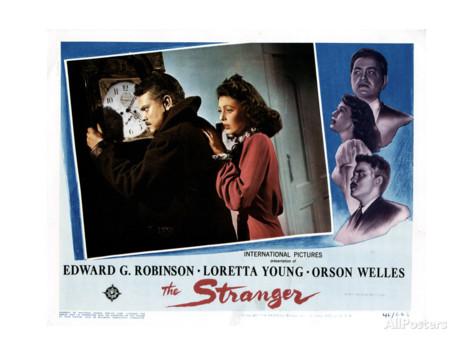The Stranger (1946) starring Orson Welles, Edward G. Robinson, Loretta Young
Synopsis of The Stranger
In The Stranger, Wilson of the War Crimes Commission is seeking Franz Kindler, mastermind of the Holocaust, who has effectively erased his identity. Wilson releases Kindler’s former comrade Meinike and follows him to Harper, Connecticut, where he is killed before he can identify Kindler. Now Wilson’s only clue is Kindler’s fascination with antique clocks; but though Kindler seems secure in his new identity, he feels his past closing in.
Review of The Stranger
Cast of characters in The Stranger

- Mr. Wilson (Edward G. Robinson, Key Largo, Five Star Final). The strange man who comes into town, after the death of a stranger. A man who’s looking for something … or someone.
- Mary Longstreet (Loretta Young, The Bishop’s Wife;Come to the Stable). Newlywed wife to a college professor, settling into her new life. Until it becomes unsettled by the arrival of Mr. Wilson. Can she believe what Wilson tells her?
- Professor Charles Rankin (Orson Welles, Citizen Kane; Black Magic). Mary’s husband, college professor, and a man who’s past is … unknown.
- Judge Adam Longstreet (Philip Merivale, Sister Kenny). Supreme court justice, and the father of Mary and Noah.
- Noah Longstreet (Richard Long, House on Haunted Hill; The Big Valley). Mary’s younger brother, and Charles’ friend. Whom Charles sends to the clock tower …
- Konrad Meinike (Konstantin Shayne, Vertigo, The Secret Life of Walter Mitty). Nazi, who runs to America in search of an escaped Nazi war criminal — and is swiftly murdered by him.
Product description of The Stranger
The Stranger, in which an ex-Nazi war criminal assumes a new identity and a new life in suburban America following World War II. But an agent from the U.N. s War Crimes Commission is on his tail, threatening to expose the lurid past and true identity he keeps secret. Orson Welles directs and stars as Charles Rankin, a professor residing in a quiet Connecticut town with his new American wife, Mary (Loretta Young).
Rankin has held strong to his fascist ideals but left nary a shred of evidence, not even a photograph, to identify him as the notorious Franz Kindler. Mr. Wilson (Edward G. Robinson), the man determined to find him, has a plan. But when that plan disappears in the woods, Wilson is left with little hope of convincing the townspeople, or Kindler s naive new wife, who this stranger in their midst really is.
Editorial review of The Stranger courtesy of Amazon.com
The legendary story that hovers over Orson Welles’s The Stranger is that he wanted Agnes Moorehead to star as the dogged Nazi hunter who trails a war criminal to a sleepy New England town. The part went to E.G. Robinson, who is marvelous, but it points out how many compromises Welles made on the film in an attempt to show Hollywood he could make a film on time, on budget, and on their own terms. He accomplished all three, turning out a stylish if unambitious film noir thriller, his only Hollywood film to turn a profit on its original release.
Welles stars as unreformed fascist Franz Kindler, hiding as a schoolteacher in a New England prep school for boys and newly married to the headmaster’s lovely if naive daughter (Loretta Young). Welles the director is in fine form for the opening sequences, casting a moody tension as agents shadow a twitchy low-level Nazi official skulking through South American ports and building up to dramatic crescendo as Kindler murders this little man, the lovely woods becoming a maelstrom of swirling leaves that expose the body he furiously tries to bury. The rest of film is a well-designed but conventional cat-and-mouse game featuring an eye-rolling performance by Welles and a thrilling conclusion played out in the dark clock tower that looms over the little village. —Sean Axmaker